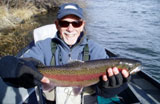Description
 During
spring and early summer, on your favorite
stream you may have noticed small, yellowish
bugs flitting about—sometimes in large
numbers. If you are fortunate enough to have
done so, you may even have seen one of them
crawling around on an exposed rock in or
near the stream. During evening’s prolific
activity, I’ve seen many a flyfisher reach
into the fly box and drag out a Light Cahill
Parachute to try and match the insects—most
always with frustrating results, having
mistaken these little critters for mayflies.
There are many adult imitations for Little
Yellow Stoneflies (aka Yellow Sallies), most
of which, to be blunt, are plainly
ineffective. They are either too bulky,
built on too big a hook, or overdressed with
flashy materials that look good to tyers but
perform poorly. During
spring and early summer, on your favorite
stream you may have noticed small, yellowish
bugs flitting about—sometimes in large
numbers. If you are fortunate enough to have
done so, you may even have seen one of them
crawling around on an exposed rock in or
near the stream. During evening’s prolific
activity, I’ve seen many a flyfisher reach
into the fly box and drag out a Light Cahill
Parachute to try and match the insects—most
always with frustrating results, having
mistaken these little critters for mayflies.
There are many adult imitations for Little
Yellow Stoneflies (aka Yellow Sallies), most
of which, to be blunt, are plainly
ineffective. They are either too bulky,
built on too big a hook, or overdressed with
flashy materials that look good to tyers but
perform poorly.
Because I’m constantly fishing and guiding on the small
streams of the upper Middle Fork American
drainage where Little Yellow Stoneflies are
prolific, I see them in huge numbers. While
I have my own patterns for imitating the
adult, I tend to fish the nymph even during
a hatch or during the evening egg-laying
flights. Sometimes I’ll use an appropriately
colored soft-hackle as an emerger imitation,
on a tandem rig with the nymph. During this
last season, I found some hatching nymphs on
exposed rocks. Turning over rocks in the
same vicinity, I located some migrating
specimens and studied them carefully,
comparing them to some imitations in my
nymph box. What I found was that my dubbing
was the wrong color—not even close—and that
my flies were too bulky. The natural was
slim-bodied and delicate, with a body color
somewhere between light olive and yellow.
The wing and abdomen case was dark brown and
segmented. Here is an image of a Little
Yellow Stonefly nymph:
Now for some technical information, adapted from
an excellent article by Rick Haefle, found
at:
http://www.west-fly-fishing.com/feature-article/0004/feature_133.php
Entomologists classify Little
Yellow Stoneflies as within the genus
Isoperla; there are many species within
this classification. The nymphs of
this group most often occur in areas with a
gravel or rocky bottom and moderate to fast
currents. They are commonly found in stream
drift, making them available and important
food items for trout. As they reach
maturity, they begin migrating to shoreline
areas in preparation for emergence. This
further increases the number of drifting
nymphs, and it is an excellent time to fish
nymphal imitations Emergence usually occurs
in typical stonefly fashion: the nymphs
crawl out of the water onto shoreline rocks
or vegetation where the adult then escapes
the nymphal shuck. However, a few species
actually emerge in open water in the surface
film, just like many mayflies. This is
unusual behavior for a stonefly, and
drifting emerger patterns become just as
important during this activity as during
similar mayfly hatches. This point is
important to remember when using Little
Yellow Stonefly nymphs. After emergence,
adults hide on streamside foliage. A quick
way to check if adults are present is to
simply look on the undersides of leaves of
streamside shrubs and trees.
The most obvious and important part of the
little yellow stone's life cycle is egg
laying. This is when swarms of adults
congregate over shallow riffles and runs.
After a short flight to gain altitude (10 to
20 feet), egg-laden females set their wings
in a shallow "V" and glide gently to the
water. As their abdomen breaks the surface
tension, a cluster of eggs is released. The
females then quickly lift off the water,
only to repeat another gliding descent to
the surface. Those lucky enough to escape
surface-feeding trout will drop five or six
times until all eggs have been laid. They
then lie spent on the surface where they
die. Most egg laying activity occurs in the
late afternoon and evening.
My Little Yellow Stonefly Nymph pattern is
simple to tie, and made from inexpensive,
commonly available materials.
Tying Instructions
|
1.
Smash the hook barb and place the hook in your vise. Wrap 4 or 5
turns of weight at the thorax
area of the hook
|
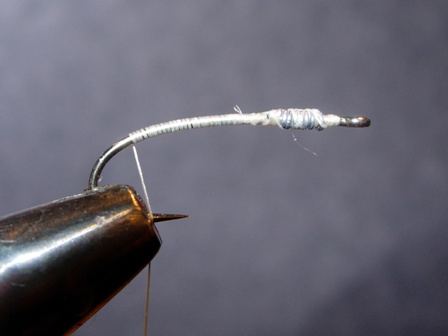 |
|
|
|
2.
Secure the weight in place with thread wraps and a drop of super
glue, and run the thread back to
the bend of the hook. At that
point tie in two biots. The
length should be about ½ shank
length.
3.
At the same point tie in a thin strip of turkey tail for the
abdomen case. Be sure that there
is no gap between the biots and
the case.
4.
At the same point tie in a piece of gold wire for ribbing.
|
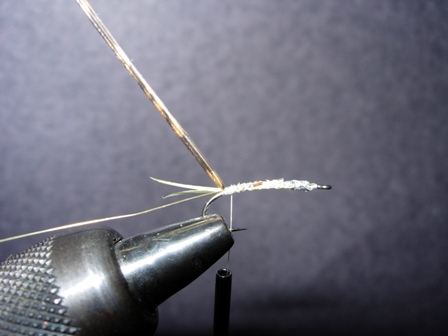 |
|
|
|
-
Dub the abdomen with a taper, larger to the front. End the dubbing
at the point where the thorax will
begin, which is about one third shank
length behind the hook eye. Do not use
excessive amounts of dubbing—the body
needs to be slender.
|
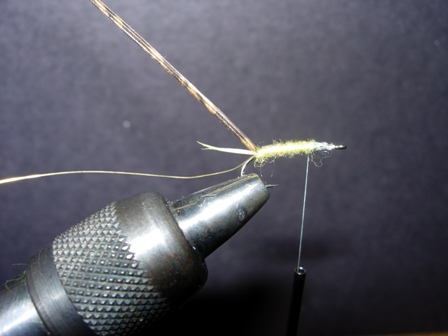 |
|
|
|
6.
Bring the case over the top of the abdomen and tie it off at the
front of the abdomen.
7.
Rib the abdomen and case with 4 or 5 turns of the wire.
|
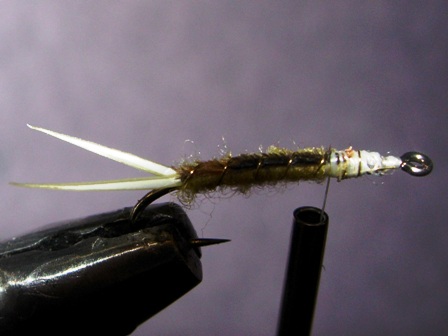 |
|
|
|
8.
Tie in a somewhat wider strip of turkey tail for the wing case, at
the front of the abdomen. The
shiny side of the feather should
be down. Be sure that there is
no gap between the abdomen and
the tied-in wing case.
9.
Prepare and tie in a partridge feather at the same point that the
wing case was tied in. See below
for tips on preparing the
feather and tying it in.
10.
Dub the thorax. It should be somewhat more robust than the abdomen,
but still slender in appearance.
11.
Pull the partridge feather over the top of the thorax and sweep the
barbules rearward, creating a
set of legs. Trim the stem of
the feather.
12.
Pull the wing case over the top of the thorax and tie it down just
behind the hook eye. This will
cause the legs to assume a
downward/rearward appearance.
13.
Form a nice small thread head and whip finish the fly. Place a drop
of super glue on the head.
|
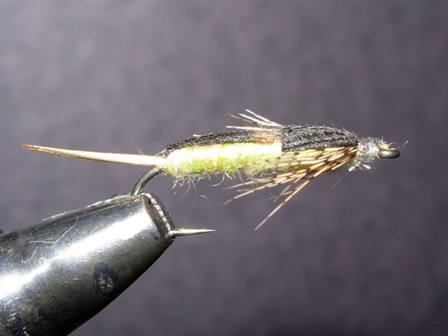 |
|
|
|
|
Tying
Tips
1.
To prepare the partridge feather, strip the fuzzy material from the
stem near the bottom of the
feather. Leave the stem intact,
with about ½” of barbules
remaining on the stem. Moisten
the feather, and using your
tweezers grab its tip and sweep
most of the barbules downward.
This leaves a small “tab” at the
top of the feather. The feather
is now prepared for tying in.
2.
Tie the feather in by the tab, with the shiny side down, directly
in front of the base of the wing
case.
3.
When tying in the biots, don’t try to tie them both in at one time.
Tie one in on the far side of
the hook, and then tie a second
one in on the close side.
When fishing this fly, remember that some (but
not all) Little Yellow
Stoneflies emerge in the stream
flow, and not by crawling to the
edge and emerging on rocks or
streamside vegetation. Tie up a
few of these, and...
|
|
|
|
|
 |
|

